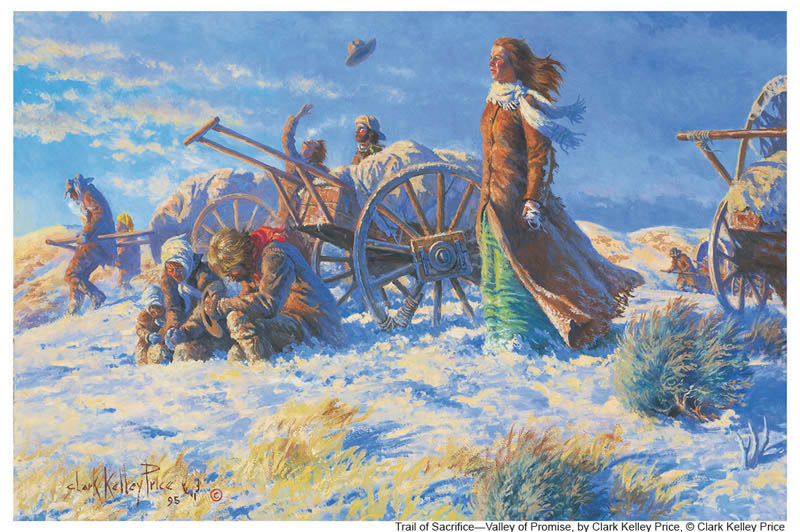It has always been a part of the heritage of members of The Church of Jesus Christ of Latter-day Saints (commonly called Mormons by friends of other faiths) to remember those who have gone before them, who have suffered for the sake of building up the kingdom of God. Some of the Latter-day Saint Church’s richest legacy comes from the pioneers who crossed the plains to enter the Salt Lake Valley. Some of these people came by handcart, walking thousands of miles while pulling their belongings behind them.
 Two of these handcart groups struck disaster in 1856, when they left later than they should have and got stuck in horrific winter storms in Wyoming. These two groups were the Willie and Martin Handcart Companies. Many Saints died along the way, but those who survived claimed they had grown closer to God through their experience than through any other experience they had throughout their lives.
Two of these handcart groups struck disaster in 1856, when they left later than they should have and got stuck in horrific winter storms in Wyoming. These two groups were the Willie and Martin Handcart Companies. Many Saints died along the way, but those who survived claimed they had grown closer to God through their experience than through any other experience they had throughout their lives.
Descendants of the Saints who travelled in the Martin Handcart Company came together in the summer of 2011 to make some of the difficult part of the trek in memory of their ancestors. It is not uncommon for members of the Mormon Church (as The Church of Jesus Christ of Latter-day Saints is often mistakenly referred to) to particpate in treks commemorating those who have gone before. However, this particular trek was the first that was solely made up of descendants of this company.
The Martin’s Cove Historic site in Wyoming is owned and operated by The Church of Jesus Christ of Latter-day Saints and is 933 acres. It is located 55 miles southwest of Casper, Wyoming. This is where 160 descendants of the Martin Handcart Company gathered in 2011 to commemorate their anscestors’ trek. Particpants ranged in age from babies to grandparents. They pulled handcarts (in pioneer dress), square-danced, played pioneer games, and listened to stories of what their ancestors suffered, sacrificed, and rose above, through the power of God.
 Leta Greene, one of the older participants, was able to do far more than she thought she would. Being wheelchair bound, she didn’t think she would be able to participate, but her children were able to pull her in her own handcart of sorts, so she was able to participate.
Leta Greene, one of the older participants, was able to do far more than she thought she would. Being wheelchair bound, she didn’t think she would be able to participate, but her children were able to pull her in her own handcart of sorts, so she was able to participate.
The trekkers were also able to cross the Sweetwater River, which their ancestors had had to cross in the middle of winter. The cold water took the lives of some of the original company, but crossing in the summer, trekkers were still able to feel a kinship with their ancestors.
People are already planning another similar reunion for descendants of the Willie Handcart Company descendants. Mormons know how important their ancestors’ sacrifices were to building up the kingdom of God. Sacrifices others have made, even if they were not direct ancestors of current members of The Church of Jesus Christ of Latter-day Saints, have helped make the Church stronger and have provided an environment of less persecution for those who practice Mormonism.

 Watch a video about the restoration of the gospel on lds.org
Watch a video about the restoration of the gospel on lds.org
I would like to share a Painting of Mormon Pioneers Pulling Handcarts.
This painting belonged to William Henry Knight a California Pioneer ( see book of that title ). He went to California working with a small wagon train in 1850. The wagon master upon reaching Salt Lake city Met with Brigham Young at first apprehensive and Brigham Young had his armed guard’s by his side. Realizing the reason was to inquire about immigration he later invited them to be his guest for dinner.
William Henry Knight sold his Buffalo Robe to obtain passage to San Fransisco in 1851. He worked for the Bancroft company. Then later the Fisher Carriage company. Surviving the Earth Quake and becoming a famous astronomer and artist This painting was in his personal collection and remained in his family for a 160 years until the death of the last heir.
This painting depicting Mormon Pioneers Pulling Handcarts meant a lot to him I do not know if he painted it when he obtained it but it is a great tribute to the MORMON history.
I would be glad to send A photo to the Mormon History Center. I will try to upload a Photo on Flickr.com titled
Yours; George A. Lee [email protected]